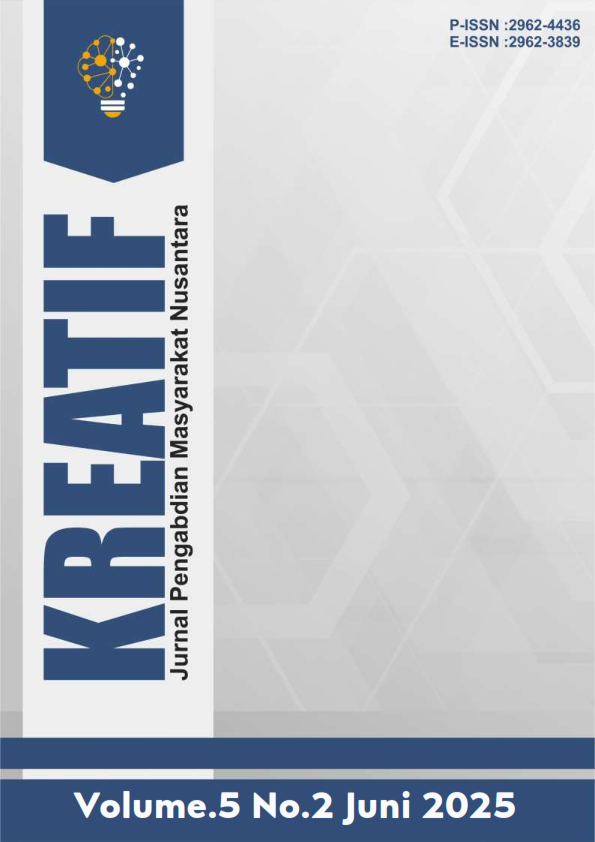Pengaruh Bantuan Sosial Program Keluarga Harapan (PKH) terhadap Tingkat Penurunan Kemiskinan Masyarakat Penerima Manfaat di Desa Pendem
DOI:
https://doi.org/10.55606/kreatif.v5i2.6577Keywords:
Program Keluarga Harapan (PKH), Poverty, Beneficiary Families (KPM)Abstract
Poverty remains a major issue faced by developing countries, including Indonesia. To address this problem, the government launched the Program Keluarga Harapan (PKH) as a conditional social assistance initiative targeted at low-income families. This study aims to analyze the influence of PKH on reducing poverty levels in Pendem Village, Karanganyar Regency. The research employed a quantitative method with a correlational approach. A total of 147 respondents were selected using a simple random sampling technique. The analysis results show that PKH has a positive and significant effect on poverty reduction, with a significance value of 0.000 < 0.05 and an R Square value of 0.354, indicating that the PKH variable explains 35.4% of the variation in poverty reduction. These findings suggest that PKH makes a real contribution to meeting basic needs, reducing economic burdens, and improving the welfare of poor communities. However, the effectiveness of PKH does not stand alone, as other factors such as education, employment opportunities, and access to basic services also influence poverty. Therefore, integration of PKH with other community empowerment programs is needed to ensure more sustainable impacts. The analytical technique used in this study is simple linear regression
References
Akhyar, M. F. A. (2023). Pengaruh Bantuan Sosial Program Keluarga Harapan (PKH) terhadap Kesejahteraan Masyarakat di Desa Sumber Kabupaten Rembang Tahun 2020.
Andrietya, A. L. (2020). Determinan Kemiskinan di Provinsi Jawa Tengah.
Ansori, R. A. AL. (2019). Analisis Faktor-Faktor yng Mempengaruhi Kemiskinan di Kabupaten Tangerang (Studi Kasus Pada Masyarakat Desa Kadu Kabupaten Tangerang).
Badan Pusat Statis. (2023). Berita Resmi Statistik.
Badan Pusat Statistik. (2023). Berita Resmi Statistik: Keadaan Ketenagakerjaan Indonesia Agustus 2023. Badan Pusat Statistik, 11(84), 1–28.
Dávila, E. S. (2023). the Impact of Economic Growth and Social Expenditure on Poverty Reduction. Panel Var Analysis for Some Latin American Countries, 2000-2019. Investigacion Economica, 82(324), 51–71. https://doi.org/10.22201/fe.01851667p.2023.324.82168
Diana, A. (2021). Pengaruh program Keluarga Harapan terhadap Kesejahtraan dalam Perspektif Ekonomi Islam (Studi Desa Pante Garot Kecamatan Indrajaya Kabupaten Pidie).
Djumura, N. P., Panigoro, M., Maruwae, A., & Popoi, I. (2022). Program Keluarga Harapan Dalam Peningkatan Kesejahteraan Masyarakat Desa Bubeya. Oikos-Nomos:Jurnal Kajian Ekonomi Dan Bisnis, 15(1), 33–42.
Eliza, R. (2019). Pengaruh Program Keluarga Harapan (Pkh) Terhadap Kesejahteraan Keluarga Penerima Manfaat (Kpm) Di Kecamatan Tampan Kota Pekanbaru. 1–95.
Hidayatulloh, A. N. (2019). Peningkatan kualitas hidup keluarga penerima manfaat dalam kajian program keluarga harapan: tinjauan empirik dampak kesejahteraan dan kualitas hidup penerima manfaat. Media Informasi Penelitian Kesejahteraan Sosial, 97–116.
Itang. (2015). Faktor faktor penyebab kemiskinan. Tazkiya: Keislaman, Kemasyarakatan Dan Kebudayaan, 16(1), 1–30.
Kementerian Sosial Republik Indonesia. (2021). Pedoman Pelaksanaan Program Keluarga Harapan. In Direktorat Jaminan Sosial keluarga Direktorat Jendral Perlindungan dan Jaminan Sosial Kementerian Sosial RI (Vol. 5, Issue 2).
Mawarni, K. S. (2019). Pengaruh Implementasi Program Keluarga Harapan Terhadap Kesejahteraan Masyarakat Oleh Pendampin Program Keluarga Harapan (PKH) Di Desa Ciomas Kecamatan Panjalau Kabupaten Ciamis. Jurnal Ilmiah Ilmu Administrasi Negara, 6(3), 56–66.
Mustaqimah, K., Hartoyo, S., & Fahmi, I. (2022). Peran Belanja Modal Pemerintah dan Investasi Pembangunan Manusia dalam Mengurangi Tingkat Kemiskinan di Indonesia. Jurnal Ekonomi Akuntansi Dan Manajemen Nusantara, 1(1), 1–15.
Prayoga, M. L., Muchtolifah, M., & Sishadiyati, S. (2021). Faktor Kemiskinan Di Kabupaten Sidoarjo. Jambura Economic Education Journal, 3(2), 135–142. https://doi.org/10.37479/jeej.v3i2.11058
Priseptian, L., & Primandhana, W. P. (2022). Analisis faktor-faktor yang mempengaruhi kemiskinan. Forum Ekonomi, 24(1), 45–53.
Raharjo, T. J., Suminar, T., & Muarifuddin. (2016). Peran Pusat Kegiatan Belajar Masyarakat dalam Menanggulangi Kemiskinan melalui Pendidikan Nonformal di Jawa Tengah. Jurnal of Nonformal Education, 1(1), 22–36.
Rahmawati, E., & Kisworo, B. (2017). Peran Pendamping dalam Pemberdayaan Masyarakat Miskin melalui Program Keluarga Harapan. Journal of Nonformal Education and Community Empowerment, 1(2), 161–169. https://doi.org/10.15294/pls.v1i2.16271
Ramadhani, N. (2017). Pemodelan Spasial Pengaruh Prasarana dan jaringan Sosial terhadap Kemiskinan di Kelurahan Wonokoyo Kecamatan Kedung Kandang. 1–5.
Sugiyono. (2023). Metode penelitian Kuantitatif Kualitatif dan R&D (Sutopo (ed.); 5th ed.). ALFABETA.
Suminar, T., Arbarini, M., Malik, A., Mulyono, S. E., Siswanto, Y., Cahyani, A. D., Aliyah, K., Astuti, D. H., & Indarthi, A. W. (2024). Penguatan keterampilan pembelajaran technopreneurship dengan metode proyek untuk penurunan kemiskinan ekstrem. Jurnal Pembelajaran Pemberdayaan Masyarakat (JP2M), 5(4), 943–956. https://doi.org/10.33474/jp2m.v5i4.22444
Theavy, C., & Mardy, S. (2023). A Review on the Best Practices of Poverty Reduction in Developing Countries. International Journal of Integrative Research, 1(12), 771–778. https://doi.org/10.59890/ijir.v1i12.1072
Zhang, Y. (2024). The Impact of Minimum Wage System on Low-Income Groups. Highlights in Business, Economics and Management, 41(June 1993), 467–471.
Downloads
Published
How to Cite
Issue
Section
License
Copyright (c) 2025 KREATIF: Jurnal Pengabdian Masyarakat Nusantara

This work is licensed under a Creative Commons Attribution-ShareAlike 4.0 International License.








